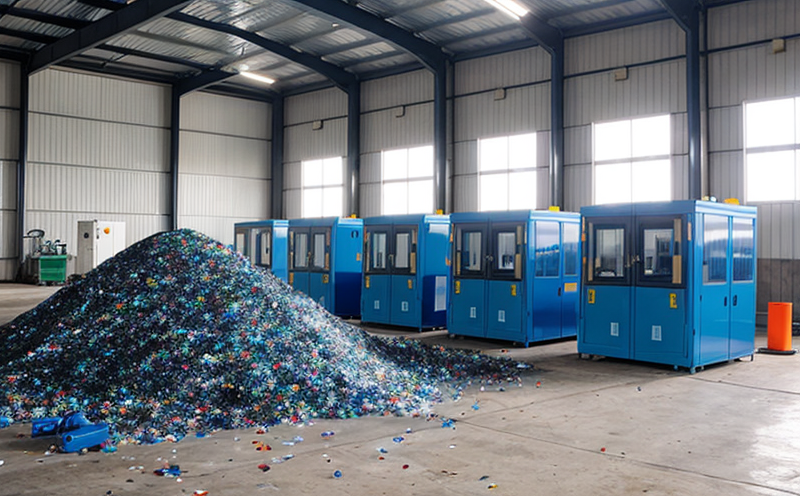ASTM D7845 Additive Residue Analysis in Recycled Plastics
The ASTM D7845 standard test method is a cornerstone for ensuring the quality and safety of recycled plastics used across numerous sectors, including packaging, consumer goods, and construction materials. This service focuses on the precise analysis of additive residues within recycled plastic products to ensure they meet stringent quality and regulatory requirements.
The ASTM D7845 standard outlines a procedure for determining the presence and quantification of residual additives in post-consumer or post-industrial plastics intended for recycling. Additives such as stabilizers, pigments, flame retardants, antioxidants, and lubricants are commonly used during the manufacturing process of plastic products. When these materials become part of recycled feedstocks, they can affect the properties and performance of new plastics.
The primary goal of ASTM D7845 is to establish a methodology that allows for accurate determination of additive residues in recycled plastics. The test involves several steps: sample preparation, extraction, analysis using spectrophotometric or chromatographic techniques, and interpretation of results. This service ensures that additives do not exceed safe levels set by regulatory bodies like the European Union's REACH regulations.
The process begins with careful selection and preparation of plastic samples. These may come from various sources such as post-consumer waste collected through municipal recycling programs or industrial scrap generated during manufacturing processes. Once prepared, these materials undergo extraction to release any residual additives present. This step often involves solvents like dichloromethane or tetrahydrofuran.
Following extraction, the sample is analyzed using advanced analytical techniques such as gas chromatography (GC), high-performance liquid chromatography (HPLC), or Fourier transform infrared spectroscopy (FTIR). These methods provide precise quantification of individual additive components. It's crucial to note that different additives may require specific testing protocols and instrumentation based on their chemical nature.
Results from these analyses are then interpreted according to ASTM D7845 guidelines, which specify acceptable limits for each type of additive. Any additives found above these thresholds must be identified and addressed through additional processing steps like cleaning or blending with virgin material before use in further manufacturing processes.
The significance of this service extends beyond mere compliance; it plays a vital role in maintaining the integrity and reputation of recycled plastics as sustainable alternatives to virgin materials. By adhering strictly to ASTM D7845, laboratories can help ensure that recycled plastic products maintain consistent quality standards across different applications. This not only enhances consumer confidence but also supports broader sustainability goals by reducing reliance on non-renewable resources.
- Reduces environmental impact through responsible recycling practices
- Promotes the use of sustainable materials in manufacturing processes
- Aids in meeting regulatory requirements for chemical safety and environmental protection
- Enhances brand reputation by ensuring product quality and reliability
Why It Matters
The analysis of additive residues in recycled plastics is critical because it directly impacts the performance, safety, and environmental footprint of plastic products. Ensuring that recycled plastics meet rigorous quality standards helps maintain product integrity while minimizing potential risks associated with residual additives.
Incorporating even trace amounts of certain additives into recycled materials could lead to unintended consequences if not properly controlled. For example, flame retardants might alter the melt flow properties of plastic resins used in extrusion processes, potentially affecting end-product quality. Similarly, uncontrolled levels of antioxidants or stabilizers could result in premature degradation of finished goods.
From a regulatory perspective, compliance with standards like ASTM D7845 ensures that recycled plastics comply with local and international laws governing chemical safety and environmental protection. This includes adherence to restrictions on hazardous substances defined by regulations such as REACH (Registration, Evaluation, Authorisation and Restriction of Chemicals) in Europe or TSCA (Toxic Substances Control Act) in the United States.
From an economic standpoint, maintaining high-quality recycled plastics supports a robust secondary market for post-consumer waste. This helps reduce raw material costs for manufacturers while fostering innovation within industries reliant on sustainable practices. Additionally, meeting stringent additive residue limits can open up new markets and opportunities for recyclers who seek to differentiate their offerings based on superior quality.
Customer Impact and Satisfaction
Customers benefit greatly from this service by gaining confidence in the quality and reliability of recycled plastics they use. Compliance with ASTM D7845 ensures that products meet stringent quality standards, which is essential for maintaining brand reputation and trust among consumers.
R&D teams can leverage accurate additive residue data to improve product design and development processes. By understanding how residual additives behave under various conditions, engineers can optimize formulations to enhance performance without compromising safety or environmental sustainability.
Quality managers gain valuable insights into supply chain management through this service. They can monitor compliance with internal specifications as well as external regulatory requirements, ensuring that all stakeholders adhere to agreed-upon standards throughout the production cycle.
Compliance officers find reassurance in knowing that their organization adheres to industry best practices and regulatory frameworks. This not only mitigates legal risks but also enhances overall corporate social responsibility (CSR) efforts by demonstrating commitment to environmental stewardship and ethical business operations.
Environmental and Sustainability Contributions
- Promotes the use of recycled materials, reducing demand for raw resources
- Reduces waste sent to landfills by converting post-consumer waste into valuable products
- Maintains product quality while minimizing environmental impact through responsible recycling practices
- Supports circular economy principles by closing loops within industrial cycles





